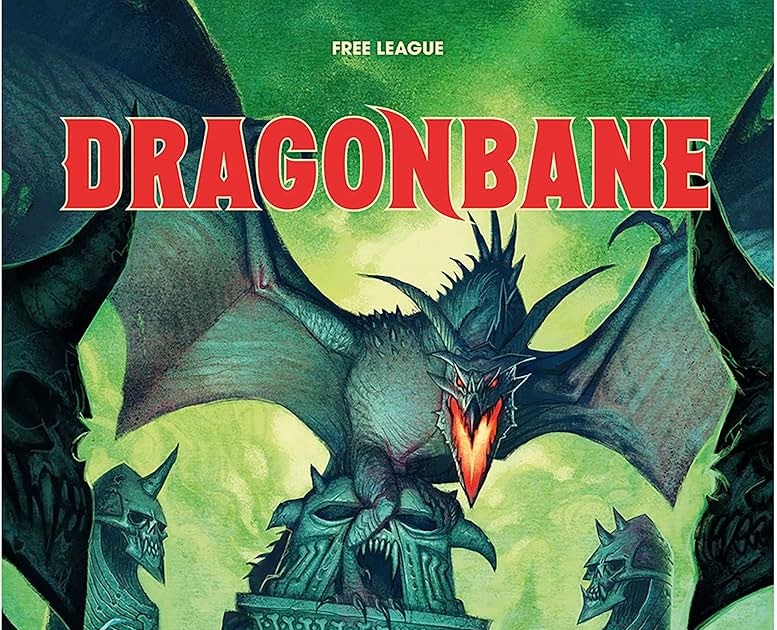SMOOSH JUICE
REVIEW: Dragonbane

Last month, I mentioned that, because of the extended absence of a player in my ongoing Dolmenwood campaign, one of the other players offered to run a short adventure using Free League’s Dragonbane rules. Despite my own deficiencies as a player, I welcomed this, both as a nice break from my own weekly refereeing duties and because I’d actually wanted to give Dragonbane a proper playtest. I’ve had a copy of the game for about two years and it wasn’t until now that an opportunity to actually make use of it arose.
We concluded our playtest earlier this week and, as I expected I would, I had a great time. Originally, my intention was to write a short follow-up to the post linked above, in which I offered some further thoughts about the game. However, as I did so, I soon realized that my “short follow-up” was rapidly turning into something closer to full-on review, The result is what you’re reading now, though be warned that this will be a somewhat idiosyncratic review based largely on my own interests rather a more “general” assessment of the game.
Case in point: I come at Dragonbane from the perspective of someone who’s played a lot of Dungeons & Dragons over the decades. And while it’s never been my system of choice, I also have a deep respect for Chaosium’s Basic Role-Playing, upon which Dragonbane‘s Swedish-language predecessor, Drakar och Demoner, was based. Consequently, I approached Dragonbane with a great deal of curiosity. I was eager to see how it would blend its BRP heritage with a more streamlined framework. After several sessions, I can confidently say Dragonbane delivers a fun, engaging experience that bridges the gap between D&D’s broad fantasy and BRP’s more grounded, skill-driven mechanics.
As I said, Dragonbane is built on the bones of Basic Role-Playing, a system known for its granular, skill-based mechanics. Free League, however, has distilled this foundation into something far lighter and more approachable, swapping BRP’s percentile dice for a d20-based system that might feel more familiar to D&D players. Character creation is quick: choose a kin (human, elf, dwarf, or even anthropomorphic creatures like wolfkin or mallard), a profession (knight, mage, artisan, etc.), and assign points to skills. Unlike the sometimes-fiddly process of building a Call of Cthulhu or RuneQuest character, Dragonbane keeps things brisk, almost rivaling old-school D&D’s straightforwardness even while retaining BRP’s emphasis on skills over character classes.
The core mechanic – roll a d20 under your skill or attribute score – will probably feel like second nature to BRP veterans, but the system’s boons and banes (the advantage/disadvantage mechanic that seems to be in every RPG these days) simplify modifiers in a way that keeps play moving. Opposed rolls and critical successes/failures add further depth without being overwhelming. For a D&D player, the shift from class-and-level progression to skill-based improvement is definitely a change. Even so, Dragonbane never feels too alien, aided not just by its use of d20 rolls but also its reliance on familiar fantasy archetypes (knights, rogues, mages, etc.).
One of Dragonbane’s most distinctive mechanical features is its use of willpower points. These function as a limited but flexible resource that can be spent to fuel both heroic abilities and spells or to reroll a failed skill check. I liked how this gave players a choice during play: burn a willpower point now to avoid a blunder or save it for a special combat move or spell later. It adds a welcome layer of resource management without being overly complex.
Dragonbane thus feels both flexible and grounded. It lacks the sprawling feat trees or subclass options of, say, WotC-era Dungeons & Dragons, but compensates with a system that rewards player ingenuity. For some BRP fans, it’s possible the game might seem too pared down. Where are the hit locations or complex magic systems of RuneQuest? But, for someone like me, more accustomed to D&D’s approach to these things, the streamlined rules felt right, emphasizing speed of play over simulationist detail.
As I noted in my earlier post, combat is where Dragonbane really shines and, as someone who often finds RPG combat a functional but unexciting necessity, I was glad of it. The system strikes a nice balance between simplicity and tactical depth, offering a dynamic experience that rivals D&D’s ease of use while avoiding the slog of overly complex BRP combat.
Each round, players draw initiative cards (reshuffled every round for unpredictability) and can move and act, with heroic abilities or even weapon choices allowing for creative flourishes. The card-based initiative is very simple and straightforward. Players can trade initiative or act out of turn in certain situations, which I found helps to keep everyone engaged. Combat maneuvers like disarming, grappling, or shoving provide further tactical options without requiring constant reference to the rulebook. Mechanics like morale checks and weapon durability add yet more stakes and flavor. For example, a critical hit includes the possibility of increased damage, ignoring armor, or gaining an additional attack.
Another feature I appreciated is the way Dragonbane distinguishes between monsters and NPCs. While NPCs use the same mechanics as player characters, monsters do not roll to attack. Instead, they act according to randomly determined behavior tables, intended to simplify referee workload and to reinforce the idea that monsters are unpredictable forces of nature. It’s an interesting design choice, but I’m not yet certain whether it works as well as intended. I’d need to play more to see how well it holds up to repeated use.
Compared to D&D and its descendants, where combat can feel like a regular cycle of attack rolls and spell slots, Dragonbane combat feels more unpredictable. Hit point totals are fairly low, which keeps fights brisk and the risk of injury or equipment failure makes every combat potentially deadly. BRP players will recognize the system’s DNA, but Dragonbane trims the fat, avoiding much of the bookkeeping that can bog down RuneQuest battles. The result is a combat system that’s both approachable and exciting, encouraging clever play without relying on too many subsystems or edge cases.
Dragonbane doesn’t come with a very detailed campaign setting of its own. Instead, its implied setting is gritty but evocative and seemed to me to take some inspiration from fairy tales (an impression born no doubt of its artwork, done by Johan Egerkrans, who also provided illustrations for the explicitly fairy tale-inspired Vaesen). The profession options suggest a world where heroism is hard-won, not guaranteed. Magic is potent but rare and monsters feel dangerous. This tone aligns more, I think, with games like RuneQuest than Dungeons & Dragons as it’s often played, though the game seems flexible enough to handle varying degrees of character skill and power.
Free League’s production quality is, as usual, stellar. The rulebook included with the boxed set is relatively concise (112 pages) yet comprehensive. The set also includes dice, cards, and a second, 116-page book containing eleven sample adventures that can be strung together to form a campaign, making it a complete package for new players. Compared to a lot of RPGs these days, Dragonbane feels leaner and more focused, while still offering enough material to fuel a campaign. BRP fans accustomed to Chaosium’s dense rulebooks might find Dragonbane’s comparative brevity a relief.
In the end, I came away from our Dragonbane playtest impressed, not just by the mechanics, but by how much fun I had. It reminded me that a well-designed game doesn’t need to be complex to offer meaningful choices and satisfying play. As someone who usually sits behind the referee’s screen, it was a pleasure to be a player again, especially in a system that hit such a sweet spot between familiarity and innovation. I’m glad I finally got to give Dragonbane a try and I hope I have the chance to return to it again in the future.

